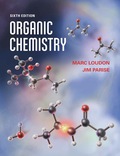
Concept explainers
(a)
Interpretation:
The two structures of semiquinone are to be drawn.
Concept introduction:
The semiquinone is a class of compound that belongs to phenol. It is known as one of the free radical compound. They are not very stable compounds. They react easily with molecular oxygen at physiological
(b)
Interpretation:
The resonance structures of semiquinones are to be drawn.
Concept introduction:
Semiquinone is a class of compound that belongs to phenol. It is known as one of the free radical compounds. They are not very stable compounds. They react easily with molecular oxygen at physiological
Want to see the full answer?
Check out a sample textbook solution
Chapter 18 Solutions
EBK ORGANIC CHEMISTRY
- Which is the stronger acid in each of the following pairs? Explain your reasoning. (a) Phenol or p-hydroxybenzaldehyde (b) m-Cyanophenol or p-cyanophenol (c) o-Fluorophenol or p-fluorophenolarrow_forwardExplain the following statements. You must use chemical equations to justify your explanation. (ii) (I) Phenol is more acidic than cyclohexanol.arrow_forwardExplain the following behaviours :(i) Alcohols are more soluble in water than the hydrocarbons of comparable molecular masses.(ii) Ortho-nitrophenol is more acidic than ortho-methoxyphenol.arrow_forward
- (a) (From benzene)arrow_forwardAnswer ALL parts of this question. (a) Compound Z is a tertiary aromatic amine with the formula, C8H11N. Provide a chemical structure for compound Z. (b) Provide a reaction scheme for the preparation of nitrous acid. (c) Draw the structure of the product formed exclusively when nitrous acid reacts with Z. (d) Give a curly arrow mechanism for the preparation of the yellow azo-dye from the reaction of Z with benzenediazonium chloride.arrow_forward(a) Give chemical tests to distinguish between(i) Phenol and Benzoic acid (ii) Benzophenone and Acetophenonearrow_forward
- (a) Although phenoxide ion has more number of resonating structures than carboxylate ion, carboxylic acid is a stronger acid than phenol. Give two reasons.(b) How will you bring about the following converstions?(i) Propanone to propane (ii) Benzoyl chloride to benzaldehyde(iii) Ethanal to but-2-enalarrow_forward(b) Distinguish each as aromatic or antiaromatic in terms of electronic basis. Explain which one is more stable. (i) Compound A Compound B (ii) Compound C Compound D (iii) Compound E Compound Farrow_forwardExplain why :(a) The dipole moment of chlorobenzene is lower than that of cyclohexyl chloride.(b) Alkyl halides, though polar, are immiscible with water.arrow_forward
- (a) Give chemical tests to distinguish between the following pairs of compounds :(i) Pentan-2-ol and Pentan-3-ol (ii) Methanol and Phenol(b) o-nitro phenol is more acidic than o-methoxy phenol. Explain why.arrow_forward(a) Account for the following :(i) Propanal is more reactive than propanone towards nucleophilic reagents.(ii) Electrophilic substitution in benzoic acid takes place at meta position.(iii) Carboxylic acids do not give characteristic reactions of carbonyl group.(b) Give simple chemical test to distinguish between the following pairs of compounds:(i) Acetophenone and benzaldehyde(ii) Benzoic acid and ethylbenzoate.arrow_forwardGive reasons: (i) Bond length of C = O in carboxylic acids is slightly larger than C = O bond length in carbonyl compounds. (ii) There are two –NH2 groups in semicarbazide. However, only one –NH2 group is involved in the formation of semicarbazones. (iii) Benzoic acid is less soluble in water than acetic acid. (iv) Formic acid is a stronger acid than acetic acid.arrow_forward
 ChemistryChemistryISBN:9781305957404Author:Steven S. Zumdahl, Susan A. Zumdahl, Donald J. DeCostePublisher:Cengage Learning
ChemistryChemistryISBN:9781305957404Author:Steven S. Zumdahl, Susan A. Zumdahl, Donald J. DeCostePublisher:Cengage Learning ChemistryChemistryISBN:9781259911156Author:Raymond Chang Dr., Jason Overby ProfessorPublisher:McGraw-Hill Education
ChemistryChemistryISBN:9781259911156Author:Raymond Chang Dr., Jason Overby ProfessorPublisher:McGraw-Hill Education Principles of Instrumental AnalysisChemistryISBN:9781305577213Author:Douglas A. Skoog, F. James Holler, Stanley R. CrouchPublisher:Cengage Learning
Principles of Instrumental AnalysisChemistryISBN:9781305577213Author:Douglas A. Skoog, F. James Holler, Stanley R. CrouchPublisher:Cengage Learning Organic ChemistryChemistryISBN:9780078021558Author:Janice Gorzynski Smith Dr.Publisher:McGraw-Hill Education
Organic ChemistryChemistryISBN:9780078021558Author:Janice Gorzynski Smith Dr.Publisher:McGraw-Hill Education Chemistry: Principles and ReactionsChemistryISBN:9781305079373Author:William L. Masterton, Cecile N. HurleyPublisher:Cengage Learning
Chemistry: Principles and ReactionsChemistryISBN:9781305079373Author:William L. Masterton, Cecile N. HurleyPublisher:Cengage Learning Elementary Principles of Chemical Processes, Bind...ChemistryISBN:9781118431221Author:Richard M. Felder, Ronald W. Rousseau, Lisa G. BullardPublisher:WILEY
Elementary Principles of Chemical Processes, Bind...ChemistryISBN:9781118431221Author:Richard M. Felder, Ronald W. Rousseau, Lisa G. BullardPublisher:WILEY





